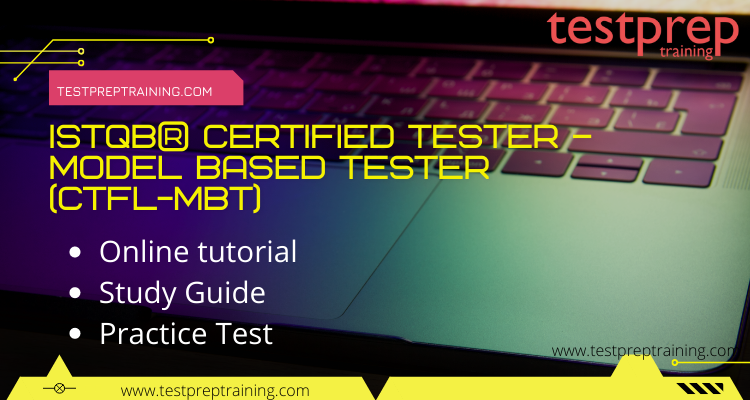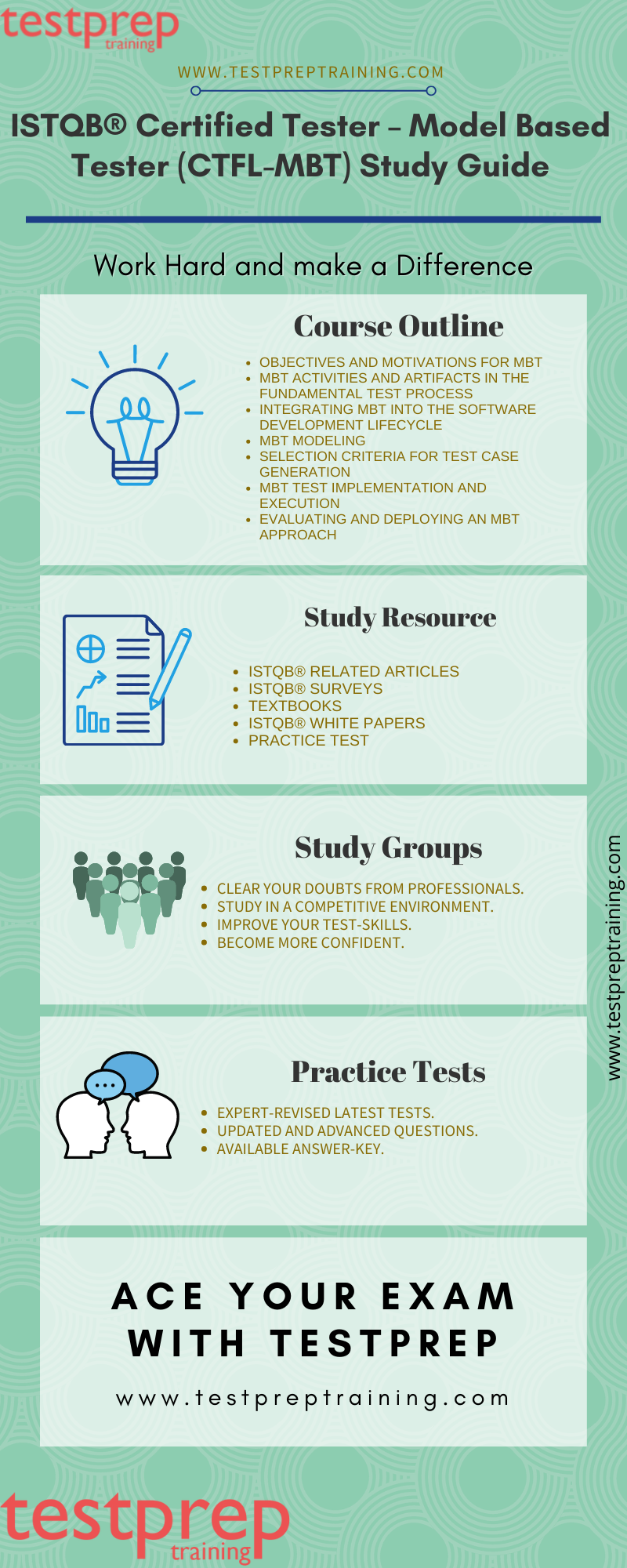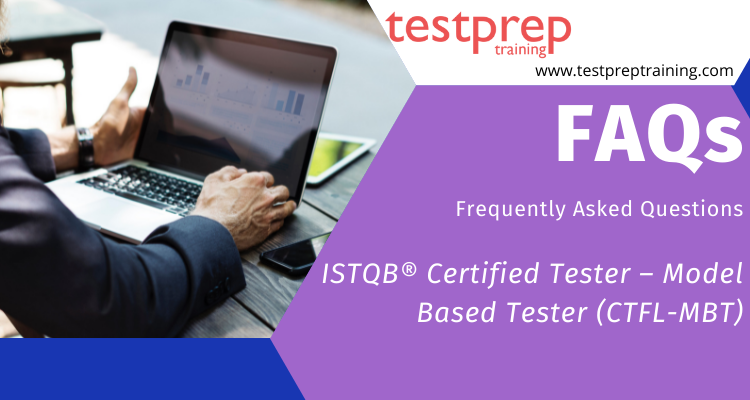ISTQB® Certified Tester – Model Based Tester (CTFL-MBT)

The ISTQB® Certified Tester – Model Based Tester (CTFL-MBT) exam is a unique certification exam administered by the ISTQB (International Software Testing Qualification Board). This certification complements the elementary foundation level as a specialist module. Furthermore, it provides a reasonable and secure entry to the MBT approach. This test is termed an innovative test because of its path to growing effectiveness and efficiency of the test process. A model-based tester on a project uses models to drive test analysis and style and keeps the advantage of the models for other testing activities like test implementation and reporting. Therefore, keeping the importance of this exam in mind we have formulated the best online tutorial to help you ace your exam with flying colors.
Exam Details
| Certification level | Foundation Level Certification exam |
| Number of Questions | 40 |
| Duration | 60 minutes |
| Passing Score | 65% |
| Test Format | Multiple-Choice Questions |
| Language available | English |
Preriquisites
The prerequisites for this exam is to commence the Model-Based Tester Foundation certification exam, you must first hold the ISTQB® Foundation Certificate.
Target Audience
The CTFL-MBT positions the following aspirant to take this exam:
- Testers
- Test Analysts
- Technical Test Analysts
- Test Managers
- System and Software Developers and Architects
- Project Managers
- Quality Managers
- Product Managers
- Business Analysts
- Business Process Experts
Learning Objectives
- Objectives and motivations for model-based testing
- Activities directed to MBT and essential MBT artifacts
- Integrating MBT into the software development lifecycle
- MBT modeling
- Test selection criteria used in model-based testing
- MBT test implementation and execution
- Evaluating and deploying an MBT Approach
Learning Outcomes
- Collaborate in a model-based testing team utilizing standard terminology and established MBT concepts, processes and techniques.
- Apply and integrate model-based testing in a test process.
- Create and maintain MBT models using established techniques and best practices of model-based testing.
- Select, create and manage test artifacts from MBT models considering risk and value of the features tested.
- Support the organization to improve its quality assurance process to be more constructive and efficient.
Schedule your Exam
- ISTQB® exams are offered through external Exam Providers and Member Boards acting as Exam Providers.
- An Exam Provider is a firm licensed by a Member Board(s) to offer exams locally and internationally.
- In order to display the list of all available Exam Providers, select All in the Exam Provider field.
Retake your Exam
You can take the exams as many times as needed to pass them. The registration fees for re-taking the exam are fixed by the local ISTQB® Member Boards and Exam Providers.
For More: Check ISTQB® Certified Tester – Model Based Tester (CTFL-MBT) FAQs
Course Outline
1 Introduction to Model-Based Testing – 90 mins.
1.1 Objectives and Motivations for MBT
- FM-1.1.1 (K2) Describe expected benefits of MBT
- FM-1.1.2 (K2) Describe misleading expectations and pitfalls of MBT
1.2 MBT Activities and Artifacts in the Fundamental Test Process
- FM-1.2.1 (K2) Summarize the activities specific to MBT when deployed in a test process
- FM-1.2.2 (K1) Recall the essential MBT artifacts (inputs and outputs)
1.3 Integrating MBT into the Software Development Lifecycle
- FM-1.3.1 (K2) Explain how MBT integrates into software development lifecycle processes
- FM-1.3.2 (K2) Explain how MBT supports requirements engineering
2 MBT Modeling – 250 mins.
2.1 MBT Modeling
- FM-2.1.1 (K3) Develop a simple MBT model for a test object and predefined test objectives using a workflow-based modeling language (refer to section 9.1 – “simple” means less than 15 modeling elements)
- FM-2.1.2 (K3) Develop a simple MBT model for a test object and predefined test objectives using a state transition-based modeling language (refer to section 9.2 – “simple” means less than 15 modeling elements)
- FM-2.1.3 (K2) Classify an MBT model with respect to the subject and to the focus
- FM-2.1.4 (K2) Give examples of how an MBT model depends on the test objectives
2.2 Languages for MBT Models
- FM-2.2.1 (K1) Recall examples of modeling language categories commonly used for MBT
- FM-2.2.2 (K1) Recall typical representatives of modeling language categories relevant for different systems and project objectives
2.3 Good Practices for MBT Modeling Activities
- FM-2.3.1 (K1) Recall quality characteristics for MBT models
- FM-2.3.2 (K2) Describe classic mistakes and pitfalls during modeling activities for MBT
- FM-2.3.3 (K2) Explain the advantages of linking requirements and process related information to the MBT model
- FM-2.3.4 (K2) Explain the necessity of guidelines for MBT modeling
- FM-2.3.5 (K2) Provide examples where reuse of existing models (from requirements phase or development phase) is or is not appropriate
- FM-2.3.6 (K1) Recall tool types supporting specific MBT modeling activities
- FM-2.3.7 (K2) Summarize iterative MBT model development, review and validation
3 Selection Criteria for Test Case Generation – 205 mins.
3.1 Classification of MBT Test Selection Criteria
- FM-3.1.1 (K2) Classify the various families of test selection criteria used for test generation from models
- FM-3.1.2 (K3) Generate test cases from an MBT model to achieve given test objectives in a given context
- FM-3.1.3 (K2) Provide examples of model coverage, data-related, pattern- and scenario-based and project-based test selection criteria
- FM-3.1.4 (K2) Recognize how MBT test selection criteria relate to ISTQB Foundation Level test design techniques
3.2 Applying Test Selection Criteria
- FM-3.2.1 (K1) Recall degrees of test artifact generation automation
- FM-3.2.2 (K3) Apply given test selection criteria to a given MBT model
- FM-3.2.3 (K2) Describe good practices of MBT test selection criteria
4 MBT Test Implementation and Execution – 120 mins.
4.1 Specifics of MBT Test Implementation and Execution
- FM-4.1.1 (K2) Explain the difference between abstract and concrete test cases in the MBT context
- FM-4.1.2 (K2) Explain the different kinds of test execution in the MBT context
- FM-4.1.3 (K3) Perform updates of an MBT model and test generation caused by changes in requirements, test objects or test objectives
4.2 Activities of Test Adaptation in MBT
- FM-4.2.1 (K2) Explain which kind of test adaptation may be necessary for test execution in MBT
5 Evaluating and Deploying an MBT Approach – 60 mins.
5.1 Evaluate an MBT Deployment
- FM-5.1.1 (K2) Describe ROI factors for MBT introduction
- FM-5.1.2 (K2) Explain how the objectives of the project are related to the characteristics of the MBT approach
- FM-5.1.3 (K1) Recall selected metrics and key performance indicators to measure the progress and results of MBT activities
5.2 Manage and Monitor the Deployment of an MBT Approach
- FM-5.2.1 (K1) Recall good practices for test management, change management and collaborative work when deploying MBT
- FM-5.2.2 (K1) Recall cost factors of MBT
- FM-5.2.3 (K2) Give examples of the integration of the MBT tool with configuration management, requirements management, test management and test automation tools
ISTQB® Certified Tester – Model Based Tester (CTFL-MBT) Study Guide
It is vital to organize for the exam with complete dedication and with the right set of data. The internet is crammed with numerous sets of study materials, handbooks, and practice papers. Therefore, instead of following the gang one should search for study material that’s latest and expert-revised. Moreover, the proper set of materials with guidance is the key to success. Since candidates are always confused regarding the right set of data, it’s our responsibility to supply you with the proper path.

Getting Familiar with the Course Outline
- Objectives and Motivations for MBT
- MBT Activities and Artifacts in the Fundamental Test Process
- Integrating MBT into the Software Development Lifecycle
- MBT Modeling
- Selection Criteria for Test Case Generation
- MBT Test Implementation and Execution
- Evaluating and Deploying an MBT Approach
Study Resources
- ISTQB® Related Articles: Look at the ISTQB® Related Articles where you can find all the related blogs and articles related to the exam from experts. We also recommend you to have a look at the referenced Articles in ISTQB® Syllabi.
- ISTQB® Surveys: The ISTQB® Surveys section consists of the surveys on Software Testing practices performed by ISTQB® Boards.
- TextBooks: You can find all the books concerning ISTQB® Certification at the ISTQB official website. The section is divided in two parts:
- the list of ISTQB® Related Books, grouped by Certification level.
- the list of Referenced Books in ISTQB® Syllabi, grouped by Certification level.
- ISTQB® White Papers: The ISTQB® White Papers are very helpful and therefore recommended by our experts as well. These papers contains detailed information of the exam and will surely help you with your preparation.
Join Online Study Groups
Joining online study groups is one of the simplest ways to enhance your studying skills. Any exam requires two things first is speed and second is accuracy. However, it’s completely your decision whether you would like to hitch such groups or not but to extend your speed and accuracy, even the toppers recommend joining study groups. These groups provide you with expert assistance and you can clear your doubts with peers as well as with professionals. Moreover, having a professional’s guidance helps keep you updated with any changes falling in any examination. Therefore, we would highly recommend every aspirant join online study groups
Take Practice Tests
Lastly, we want our users to receive the best service and study material, so, we have made the most latest and expert-revised practice test papers for the ISTQB® Certified Tester – Model Based Tester (CTFL-MBT). Therefore, while preparing for any examination the most important step is to take Practice tests. Moreover, these tests assist you to check your preparation level, build your confidence and time management, and assist you to get conversant in differing types of questions that are commonly asked in the examination. Moreover, you can take our practice test right now, which consists of questions from basic to advanced levels in a systematic manner. Therefore, keep working and ace the exam.


